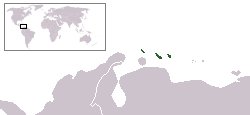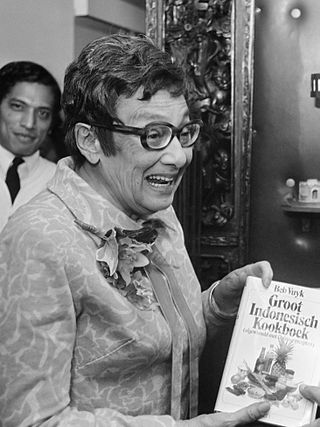
Papiamento or Papiamentu is a Portuguese-based creole language spoken in the Dutch Caribbean. It is the most widely spoken language on the Caribbean ABC islands.
Sranan Tongo is an English-based creole language that is spoken as a lingua franca by approximately 519,600 people in Suriname.
Indonesian and Malaysian Malay are two standardised varieties of the Malay language, the former used officially in Indonesia and the latter in Brunei, Malaysia and Singapore. Both varieties are generally mutually intelligible, yet there are noticeable differences in spelling, grammar, pronunciation and vocabulary, as well as the predominant source of loanwords. The differences can range from those mutually unintelligible with one another, to those having a closer familial resemblance. The regionalised and localised varieties of Malay can become a catalyst for intercultural conflict, especially in higher education.
Negerhollands ('Negro-Dutch') was a Dutch-based creole language that was spoken in the Danish West Indies, now known as the U.S. Virgin Islands. Dutch was its superstrate language with Danish, English, French, Spanish, and African elements incorporated. Notwithstanding its name, Negerhollands drew primarily from the Zeelandic rather than the Hollandic dialect of Dutch.

Javindo, also known by the pejorative name Krontjong, is a Dutch-based creole language spoken on Java, Indonesia. The name Javindo is a portmanteau of Java and Indo, the Dutch word for a person of mixed Indonesian and Dutch descent. This contact language developed from communication between Javanese-speaking mothers and Dutch-speaking fathers in Indo families. Its main speakers were Indo-Eurasian people. Its grammar was based on Javanese, and its vocabulary was based on the Dutch lexicon but pronounced in a Javanese manner.
Tjalie Robinson is the main alias of the Indo (Eurasian) intellectual and writer Jan Boon also known as Vincent Mahieu. His father Cornelis Boon, a Royal Netherlands East Indies Army (KNIL) sergeant, was Dutch and his Indo-European mother Fela Robinson was part Scottish and Javanese.
The modern Malay and Indonesian alphabet consists of the 26 letters of the ISO basic Latin alphabet. It is the more common of the two alphabets used today to write the Malay language, the other being Jawi. The Latin Malay alphabet is the official Malay script in Indonesia, Malaysia and Singapore, while it is co-official with Jawi in Brunei.

Dutch is a West Germanic language, spoken by about 25 million people as a first language and 5 million as a second language and is the third most spoken Germanic language. In Europe, Dutch is the native language of most of the population of the Netherlands and Flanders. In South America, it is the native language of the majority of the population of Suriname, and spoken as a second language in the polyglot Caribbean island countries of Aruba, Curaçao and Sint Maarten. All these countries have recognised Dutch as one of their official languages, and are involved in one way or another in the Dutch Language Union. Dutch Caribbean municipalities have Dutch as one of the official languages too. Up to half a million native speakers reside in the United States, Canada and Australia combined, and historical linguistic minorities on the verge of extinction remain in parts of France and Germany.

Acehnese or Achinese is an Austronesian language natively spoken by the Acehnese people in Aceh, Sumatra, Indonesia. This language is also spoken by Acehnese descendants in some parts of Malaysia like Yan, in Kedah. Acehnese is used as the co-official language in the province of Aceh, Indonesia. Besides Indonesian used as the official language.

Afrikaans is a daughter language of Dutch mainly spoken in South Africa and Namibia; it is a separate standard language rather than a national variety, unlike Netherlands Dutch, Belgian Dutch and Surinamese Dutch. An estimated 90 to 95% of Afrikaans vocabulary is ultimately of Dutch origin, so there are few lexical differences between the two languages, however Afrikaans has considerably more regular morphology, grammar, and spelling.

Adriaan van Dis is a Dutch author. He debuted in 1983 with the novella Nathan Sid. In 1995 his book Indische Duinen, which in its narrative is a follow-up to his debut novella, was also awarded several prestigious literary awards.

Robert Nieuwenhuys was a Dutch writer of Indo descent. The son of a 'Totok' Dutchman and an Indo-European mother, he and his younger brother Roelof, grew up in Batavia, where his father was the managing director of the renowned Hotel des Indes.

Elizabeth (Beb) Vuyk was a Dutch writer of Indo (Eurasian) descent. Her Indo father was born in the Dutch East Indies and had a mother from Madura, but was ‘repatriated’ to the Netherlands on a very young age. She married into a typically Calvinist Dutch family and lived in the port city of Rotterdam. Vuyk grew up in the Netherlands and went to her father’s land of birth in 1929 at the age of 24. 3 years later she married Fernand de Willigen, a native born Indo that worked in the oil and tea plantations throughout the Indies. They had 2 sons, both born in the Dutch East Indies.

Marion Bloem is a Dutch writer and film maker of Indo descent, best known as author of the literary acclaimed book Geen gewoon Indisch meisje and director of the 2008 feature film Ver van familie.
Kei is an Austronesian language spoken in a small region of the Moluccas, a province of Indonesia.

Indos are a Eurasian people of mixed Indonesian and European descent. The earliest evidence of Eurasian communities in the East Indies coincides with the arrival of Portuguese traders in the 16th century. Eurasian communities, often with distinct, specific names, also appeared following the arrival of Dutch (VOC) traders in the 17th and 18th century.

The Bataviaasch Nieuwsblad was one of the leading and largest daily newspapers in the Dutch East Indies. It was based in Batavia on Java, but read throughout the archipelago. It was founded by the famous Dutch newspaperman and author P. A. Daum in 1885 and existed to 1957.

Dutch Indies literature or Dutch East Indies literature is the Dutch language literature of colonial and post-colonial Indonesia from the Dutch Golden Age to the present day. It includes Dutch, Indo-European and Indonesian authors. Its subject matter thematically revolves around the VOC and Dutch East Indies eras, but also includes the postcolonial discourse.

The Van Ophuijsen Spelling System was the Romanized standard orthography for the Indonesian language from 1901 to 1947. Before the Van Ophuijsen Spelling System was in force, the Malay language in the Dutch East Indies did not have a standardized spelling, or was written in the Jawi script. In 1947, the Van Ophuijsen Spelling System was replaced by the Republican Spelling System.

The Indo people or Indos are Eurasian people living in or connected with Indonesia. In its narrowest sense, the term refers to people in the former Dutch East Indies who held European legal status but were of mixed Dutch and indigenous Indonesian descent as well as their descendants today.












